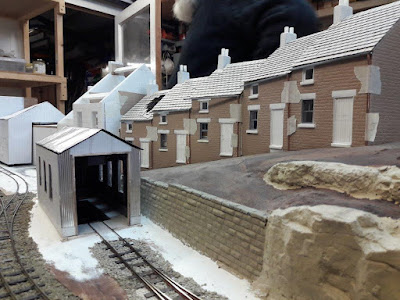Replace the loom connector on the bridge board with a larger unit to accommodate the new section wiring from the Masons yard.
Modify the loom connections on the station board by replacing the two 'supplementary' connectors fitted previously with a single plug and socket.
Just Geoff and Stephen today.
When adding features to the layout some time ago, a few extra wires across the boards were required, but there was no spare capacity in our 'Cinch' connectors. We took the simple way out and added a spare, but unusual 5-way connector, which was always a bit awkward to connect. We now decided to replace this with another Cinch. However, the only spare 'sets' we had were 20-way, far in excess of our requirement. We did have a spare 12-way socket, so we decided to cut a 20-way plug down and produce 12-way and 8-way plugs. The 12-way male unit was wired-up and fitted on the board.
 |
| 12-way fitted to the Bridge board, with the residual 8-way awaiting fitting on the Station board. |
Geoff had previously 3D printed covers for Cinch connectors, but he now modified one of his existing drawings for the 8-way, with off-set fixing holes, and set the printer going. By lunchtime, the new cover was ready.
 |
| Cut-down 8-way plug with new cover. |
Station board - We didn't have a spare 8-way female socket, so rather than cut a new 20-way down to size, we fitted an unmodified 20-way and blanked off the unused holes. We can always change the plug if more wires are needed in the future.
Stephen had made up a panel for the new track section change-over switch, which was now trimmed to size and shape. A miniature SPDT switch was wired-up and fitted, before the panel was fitted beside the signal control panel, which was moved the previous week. Labelling was also added.
It was good to get the new section wiring completed, but next week, the rail joint will be cut and the system tested. Modifying the connectors was certainly a worthwhile job and will simplify assembly of the loom in the future.
Finally, Stephen floated an idea he'd had for the masons building. The original idea was that the track went INTO the building, but this surely put a restriction on the types of loco that could go inside? It could create an interesting need for a small IC loco to be used when a steam loco dropped something off, but maybe not. However, he now proposed there be two buildings, with a structure spanning the track between them and a gate below, that would still disguise views of the fiddleyard beyond, where wagon exchange would take place. Separate roof areas create an interesting arrangement with scope for different materials and features, such as a tank house. A new mock-up will be required to investigate the idea further.


































